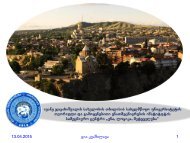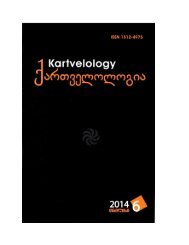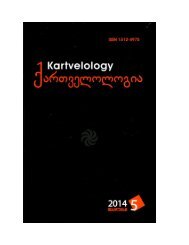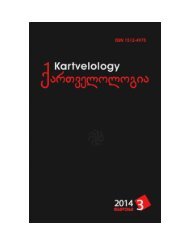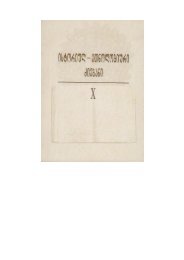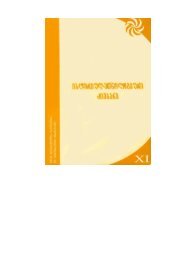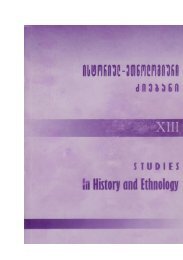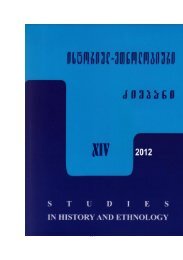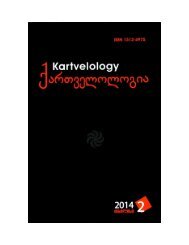Kvashilava, Gia, 2010. On Reading Pictorial Signs of the Phaistos Disk and Related Scripts (2). Rosette (in Georgian and English)
This study concerns the graphic character, symbolic meanings, typological parallels, commentaries and reading of the Phaistos Disk pictorial sign PHD38.
This study concerns the graphic character, symbolic meanings, typological parallels, commentaries and reading of the Phaistos Disk pictorial sign PHD38.
You also want an ePaper? Increase the reach of your titles
YUMPU automatically turns print PDFs into web optimized ePapers that Google loves.
229 (433), 193; Kajaia 2001, I, 169; Mikeladze 1974; Antelava<br />
2006, 5; Gordeziani 1999, 53; 2007, III, 474).<br />
5. About Geographical Location <strong>of</strong> Aea<br />
As mentioned above, <strong>the</strong> sign PHD38 <strong>of</strong> <strong>the</strong> eightpetalled<br />
rosette is read by me as * [*aəa] – <strong>the</strong> country Aea,<br />
below <strong>the</strong> geographical location <strong>of</strong> this country is considered.<br />
The commentaries <strong>of</strong> Ancient Greek authors, <strong>the</strong> Assyrian <strong>and</strong><br />
Urartian sources <strong>and</strong> <strong>the</strong> results <strong>of</strong> <strong>the</strong> analyses <strong>of</strong> <strong>the</strong>se should<br />
be presented here (see Lordkipanidze 1986, 30-76).<br />
Bas<strong>in</strong>g on Herodotus (Aea – Colchis: I, 2; VII, 193, 197;<br />
Colchians: II, 103-105; III, 97; IV, 37, 40; VII, 79), Apollonius <strong>of</strong><br />
Rhodes (Aea: II, 422, 1094, 1141, 1185, 1267; III, 306, 1061; IV,<br />
255, 277-278; Colchis: I, 174; II, 1277; III, 313; IV, 33; Aea –<br />
Colchis: II, 417), Strabo (XI, 1, 4; 2, 1; 2, 14-18; 3, 2; 3, 4; 5, 5; 14,<br />
4; 14, 15; XII, 1, 1; 3, 1-2; 3, 13; 3, 17-18; 3, 28-29; 4, 3) <strong>and</strong><br />
o<strong>the</strong>rs (Euripid., Medea 2), S. Kaukhchishvili (1964, 9-14; 1970,<br />
VIII, 2-4), T. Kaukhchishvili (1960, 18-19, 48-49; 1976-b, 12, 18-<br />
19), A. Urushadze (1970, 28-29, 347 10 ; 1964, 6-8, 10, 63-64) <strong>and</strong><br />
O. Lordkipanidze (1986, 32, 43, 128 8 ; 1989, 213; 2000, 9 1 ) argue<br />
that Aea is <strong>the</strong> synonym <strong>of</strong> Colchis ( / ), Aea is <strong>the</strong><br />
oldest name <strong>of</strong> this country, <strong>and</strong> it was called Colchis only later<br />
(also see: Smith 1896, 15; Perr<strong>in</strong>, Seymour 1897, Vocabulary, 3;<br />
Gamkrelidze, Ivanov II, 907, 907 1 , 908; Gambaschidze,<br />
Hauptmann, Slotta, Yalç<strong>in</strong> 2001, 196 <strong>and</strong> ff.; Gordeziani 2007, III,<br />
469, 473).<br />
S. Kaukhchishvili (1964, 13), A. Urushadze (1964, 6-10)<br />
<strong>and</strong> O. Lordkipanidze (2000, 9 1 ) argue that accord<strong>in</strong>g to Greek<br />
sources Aea (resp. Eëa) was <strong>the</strong> oldest name <strong>of</strong> Georgia.<br />
Bas<strong>in</strong>g on Hecataeus <strong>of</strong> Miletus 1 (<strong>the</strong> 6 th c. BC), M. Janashvili<br />
(1906, 3) writes: ”Moskhians (Moschi = Meskhs =<br />
Meskhetians = <strong>Georgian</strong>s) are Colchian tribes. So, Colchians<br />
1 . “ , “ (Hecatæi fragmenta<br />
188, Müllerus 1841, I, 13; also see: Lomouri 1963; Khazaradze 1984).<br />
311




